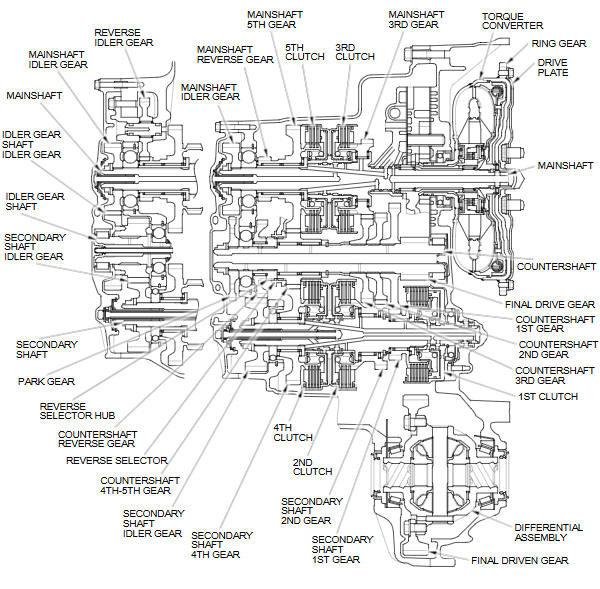Honda Fit: A/T System Description - Clutches and Gears (A/T)
The five-speed automatic transmission uses hydraulically-actuated clutches to engage or disengage the transmission gears. When hydraulic pressure is introduced into the clutch drum, the clutch piston moves. This presses the friction discs and steel plates together, locking them so they do not slip. Power is then transmitted through the engaged clutch pack to its hub-mounted gear. Likewise, when the hydraulic pressure is bled from the clutch pack, the piston releases the friction discs and the steel plates, and they are free to slide past each other. This allows the gear to spin independently on its shaft, transmitting no power.
Transmission Cutaway View

1st Clutch
The 1st clutch engages/disengages 1st gear, and is located at the left end of the secondary shaft, opposite the end cover. The 1st clutch is supplied hydraulic pressure through the mainshaft by a circuit connected to the internal hydraulic circuit.
2nd Clutch
The 2nd clutch engages/disengages 2nd gear, and is located at the middle of the secondary shaft. The 2nd clutch is joined back-to-back to the 4th clutch. The 2nd clutch is supplied hydraulic pressure by its ATF feed pipe within the secondary shaft.
3rd Clutch
The 3rd clutch engages/disengages 3rd gear, and is located at the middle of the mainshaft. The 3rd clutch is joined back-to-back to the 5th clutch. The 3rd clutch is supplied hydraulic pressure through the mainshaft by its ATF feed pipe within the mainshaft.
4th Clutch
The 4th clutch engages/disengages 4th gear, and is located at the middle of the secondary shaft. The 4th clutch is joined back-to-back to the 2nd clutch, and is supplied hydraulic pressure by its ATF feed pipe within the secondary shaft.
5th Clutch
The 5th clutch engages/disengages 5th gear, as well as reverse gear, and is located at the middle of the mainshaft. The 5th clutch is joined back-to-back to the 3rd clutch. The 5th clutch is supplied hydraulic pressure through the mainshaft by a circuit connected to the internal hydraulic circuit.
Gear Operation
Gears on the mainshaft:
-
3rd gear is engaged/disengaged with the mainshaft by the 3rd clutch.
-
5th gear is engaged/disengages with the mainshaft by the 5th clutch.
-
Reverse gear is engaged/disengaged with the mainshaft by the 5th clutch.
-
Idler gear is splined with the mainshaft, and rotates with the mainshaft.
Gears on the countershaft:
-
Final drive gear is integral with the countershaft.
-
1st gear, 2nd gear, and park gear are splined with the countershaft, and rotate with the countershaft.
-
4th-5th gear and reverse gear rotate freely from the countershaft. The reverse selector engages 4th-5th gear and reverse gear with the reverse selector hub. The reverse selector hub is splined to the countershaft so 4th-5th gear and reverse gear engage with the countershaft.
Gears on the secondary shaft:
-
1st gear is engaged/disengaged with the secondary shaft by the 1st clutch.
-
2nd gear is engaged/disengaged with the secondary shaft by the 2nd clutch.
-
4th gear is engaged/disengaged with the secondary shaft by the 4th clutch.
-
Idler gear is splined with the secondary shaft, and rotates with the secondary shaft.
The idler gear on the idler gear shaft transmits power between the mainshaft and the secondary shaft.
The reverse idler gear transmits power from the mainshaft reverse gear to the countershaft reverse gear, and changes rotational direction of the countershaft reverse.
See also:
Transmission End Cover Transmission Fluid Pressure Switch Replacement (A/T)
Remove the transmission fluid pressure switch A (2nd clutch) (A).
Make sure there is no water, oil, dust, or foreign particles inside the
connector.
Install the new tr ...
Playing a USB Flash Drive
Your audio system reads and plays sound files on a USB flash drive in either
MP3,
WMA or AAC*1 format.
Connect your USB flash drive to the USB adapter cable, then press the AUX
button.
*1:O ...
Valve Inspection
Remove the valves.
Measure the valve in these areas.
Intake Valve Dimensions
A Standard (New):
27.85пјЌ28.15 mm (1.0965пјЌ1.108 ...
